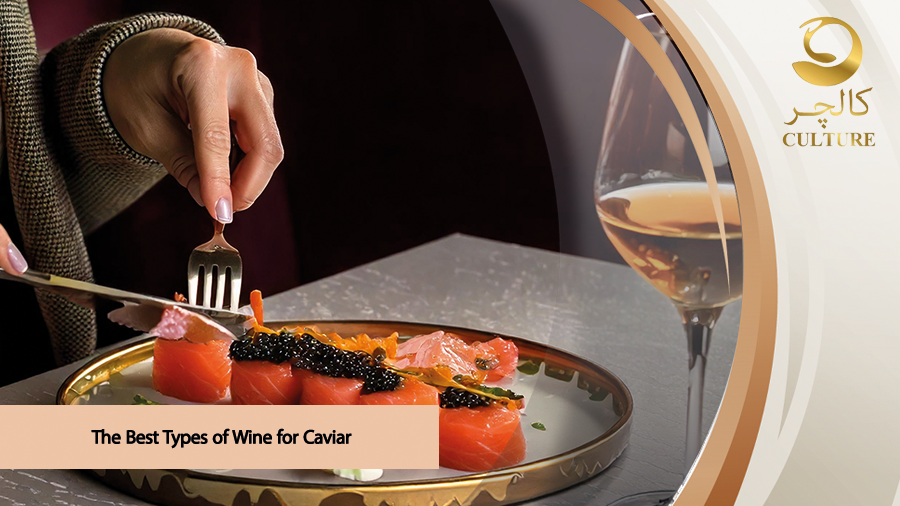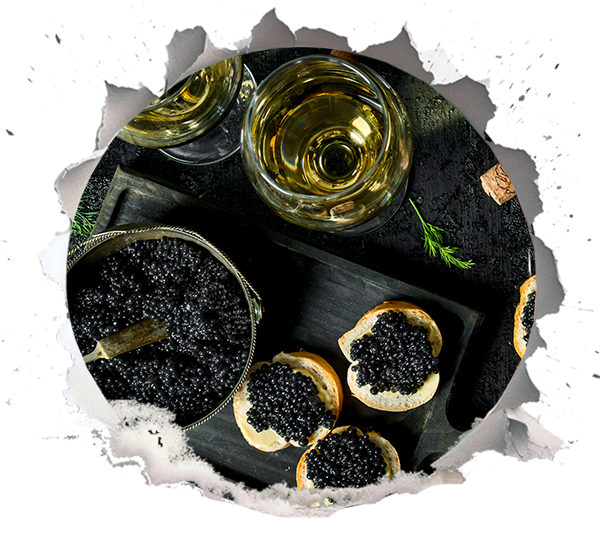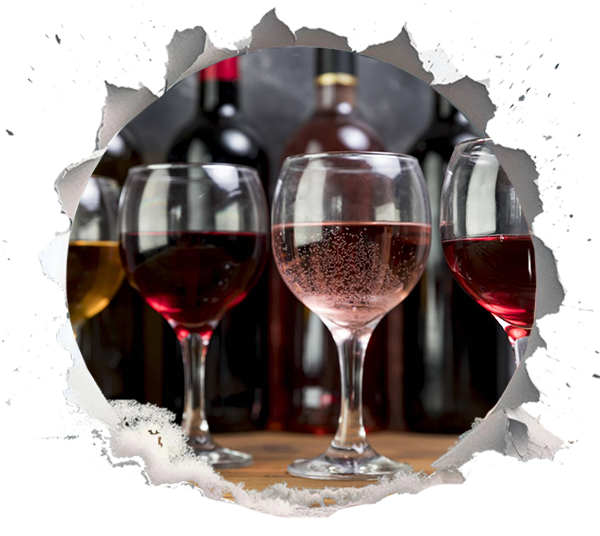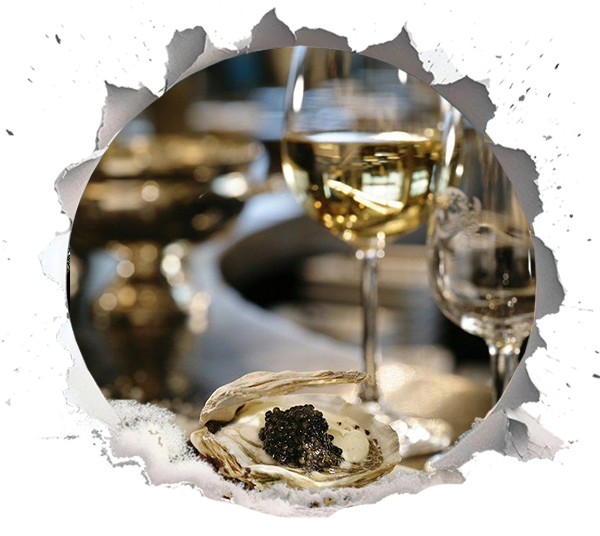Wine Pairings Guide: The Best Types of Wine for Caviar

Caviar has traditionally been paired with champagne, but many connoisseurs are now exploring the delightful possibility of pairing caviar with wine. If you’re curious about the idea of enhancing your caviar experience with wine, you’re in good company. In this article, we will discuss the best types of wine to enjoy with caviar, including some unexpected pairings that challenge conventional choices.
The Allure of Caviar
Before we explore these pairings, let’s take a moment to appreciate caviar itself. Traditionally, caviar refers to the salted roe (fish eggs) of sturgeon, particularly the varieties from the Caspian Sea, including Beluga, Ossetra, and Sevruga. The unique textures and flavours of these caviars can vary significantly, which is why the choice of wine is crucial for an enhanced tasting experience.
Why Wine Instead of Champagne?
Champagne has traditionally been the preferred beverage to pair with caviar. However, some experts argue that wine can enhance the nuanced flavours of the roe even more effectively. While champagne’s bubbles and acidity can sometimes overpower the delicate taste of caviar, the wine offers a wider range of flavours and aromas that complement the richness of caviar without overshadowing it.
A recent survey conducted by the International Wine and Spirit Competition found that approximately 30% of caviar enthusiasts now prefer to pair wine with this luxurious delicacy instead of champagne, indicating a significant shift in consumer preferences.
Types of Caviar and the Best Wine Pairings for Them

1. Beluga Caviar
Characteristics: Beluga caviar is known for its large, soft pearls and rich, buttery flavour.
Best Wine for Beluga Caviar: The ideal wine for Beluga caviar is a crisp, mineral-driven white such as a Chablis from Burgundy (It’s actually closer to champagne than much of the rest of Burgundy). The wine’s acidity cuts through the richness of the caviar, while its elegant notes of citrus and stone fruit enhance the overall experience.
2. Ossetra Caviar
Characteristics: Osetra caviar has a medium-sized bead and a nutty, briny flavour that varies depending on the fish’s diet.
Best Wine Pairing: A Sauvignon Blanc from the Loire Valley is an excellent choice for Ossetra caviar. Sauvignon blanc is a green-skinned grape variety that originates from France. The wine’s vibrant acidity and grassy notes beautifully contrast the nutty richness of the caviar. Alternatively, champagne can also work well in this pairing but don’t overlook the white wine option.
3. Sevruga Caviar
Characteristics: Smaller and darker than Beluga and Osetra, Sevruga caviar is known for its intense briny flavour.
Best Wine for Sevruga Caviar: A dry Riesling, especially one from Alsace, can be an unexpected yet delightful match for Sevruga Caviar. Dry Riesling, characterized by its high acidity and minimal residual sugar, offers flavours of citrus, green apple, and stone fruits, often accompanied by floral and mineral notes. The wine’s acidity and hint of sweetness balance the saltiness of the caviar, creating a harmonious pairing.
4. Caspian Sea Caviar
Characteristics: Representing some of the finest caviar in the world, Caspian Sea caviar includes varieties like Beluga, Sterlet, Kaluga hybrid, Ossetra, Siberian sturgeon and Sevruga.
Best Wine Pairing: For those seeking the perfect match for expensive Caspian Sea caviar, Pinot Grigio and Pinot Noir stand out as exceptional choices. The crisp acidity and fresh fruit notes of Pinot Grigio enhance the delicate flavours of the caviar, creating a refreshing and harmonious experience. On the other hand, Pinot Noir, with its elegant structure and subtle earthiness, complements the rich, buttery characteristics of the caviar beautifully. This combination not only honours the luxurious nature of the caviar but also offers a delightful contrast that elevates the tasting experience.
Exploring Other Wine Options

Caviar pairs best with dry, well-balanced white wines for several reasons:
- Acidity: Dry white wines typically have higher acidity, which helps to cut through the richness and buttery texture of caviar. This acidity enhances the overall tasting experience by refreshing the palate between bites.
- Flavour Profile: The delicate and nuanced flavours of caviar can be overshadowed by bold red wines or very fruity whites. Dry white wines often possess subtle notes of citrus, green apple, and minerality, which complement the briny and umami flavours of caviar without overpowering them.
- Texture: The light and crisp nature of dry white wines matches well with the smooth texture of caviar. This pairing creates a harmonious mouthfeel, where neither the wine nor the caviar feels too heavy or overwhelming.
- Complexity: Well-balanced white wines offer complexity without being overly aggressive. They can have layers of flavours that unfold as you sip, mirroring the intricate taste profile of the caviar, thereby enhancing the tasting experience.
- Tradition: Historically, caviar has been paired with sparkling wines and dry whites, making this combination a time-honoured choice for connoisseurs who appreciate the classic elegance of these pairings.
Sparkling Wines
If you prefer a sparkling wine, consider trying Prosecco or Franciacorta. These Italian sparkling wines are less intense than champagne and provide a fruitier flavour that pairs well with different types of caviar. Additionally, they are not overly expensive!
Orange Wines
Orange wines, made from white grapes that have been fermented with their skins, are becoming increasingly popular. Their tannins and complex flavours can create an intriguing contrast with caviar. A Georgian Rkatsiteli would be a fascinating choice to explore.
Dessert Wines
For a unique twist, consider pairing caviar with a sweet wine, such as Sauternes. Sauternes is a French dessert wine from the region of the same name in the Graves section of Bordeaux. It is made from Sémillon, Sauvignon Blanc, and Muscadelle grapes that have been affected by Botrytis cinerea, commonly known as noble rot. The sweet, honeyed notes of Sauternes can create an interesting balance with the salty caviar, enhancing the overall tasting experience.
The Art of Pairing

Serving Suggestions
When serving caviar with wine, it’s essential to consider the serving temperature. Caviar is best served chilled, ideally on a bed of crushed ice, while white wines should be served at around 8-10°C (46-50°F) and red wines slightly cooler at about 14-16°C (57-61°F).
Tasting Notes
Encourage your guests to take their time with both the caviar and the wine. Swirl the wine in the glass, and inhale its aromas. And take small sips to appreciate how it interacts with the caviar. This is not just about eating and drinking; it’s about the entire sensory experience. As a creative addition to your caviar experience, you might also consider exploring caviar cocktails. These innovative drinks often incorporate caviar as a garnish or infusion, showcasing its unique flavours in a new light. Pairing a well-made caviar cocktail with the right beverage can elevate your dining experience to new heights.
Caviar has traditionally been paired with champagne, but many connoisseurs are now exploring the delightful possibility of pairing caviar with wine. If you’re curious about the idea of enhancing your caviar experience with wine, you’re in good company. In this article, we will discuss the best types of wine to enjoy with caviar, including some unexpected pairings that challenge conventional choices.
The Allure of Caviar
Before we explore these pairings, let’s take a moment to appreciate caviar itself. Traditionally, caviar refers to the salted roe (fish eggs) of sturgeon, particularly the varieties from the Caspian Sea, including Beluga, Ossetra, and Sevruga. The unique textures and flavours of these caviars can vary significantly, which is why the choice of wine is crucial for an enhanced tasting experience.
Why Wine Instead of Champagne?
Champagne has traditionally been the preferred beverage to pair with caviar. However, some experts argue that wine can enhance the nuanced flavours of the roe even more effectively. While champagne’s bubbles and acidity can sometimes overpower the delicate taste of caviar, the wine offers a wider range of flavours and aromas that complement the richness of caviar without overshadowing it.
A recent survey conducted by the International Wine and Spirit Competition found that approximately 30% of caviar enthusiasts now prefer to pair wine with this luxurious delicacy instead of champagne, indicating a significant shift in consumer preferences.
Types of Caviar and the Best Wine Pairings for Them

1. Beluga Caviar
Characteristics: Beluga caviar is known for its large, soft pearls and rich, buttery flavour.
Best Wine for Beluga Caviar: The ideal wine for Beluga caviar is a crisp, mineral-driven white such as a Chablis from Burgundy (It’s actually closer to champagne than much of the rest of Burgundy). The wine’s acidity cuts through the richness of the caviar, while its elegant notes of citrus and stone fruit enhance the overall experience.
2. Ossetra Caviar
Characteristics: Osetra caviar has a medium-sized bead and a nutty, briny flavour that varies depending on the fish’s diet.
Best Wine Pairing: A Sauvignon Blanc from the Loire Valley is an excellent choice for Ossetra caviar. Sauvignon blanc is a green-skinned grape variety that originates from France. The wine’s vibrant acidity and grassy notes beautifully contrast the nutty richness of the caviar. Alternatively, champagne can also work well in this pairing but don’t overlook the white wine option.
3. Sevruga Caviar
Characteristics: Smaller and darker than Beluga and Osetra, Sevruga caviar is known for its intense briny flavour.
Best Wine for Sevruga Caviar: A dry Riesling, especially one from Alsace, can be an unexpected yet delightful match for Sevruga Caviar. Dry Riesling, characterized by its high acidity and minimal residual sugar, offers flavours of citrus, green apple, and stone fruits, often accompanied by floral and mineral notes. The wine’s acidity and hint of sweetness balance the saltiness of the caviar, creating a harmonious pairing.
4. Caspian Sea Caviar
Characteristics: Representing some of the finest caviar in the world, Caspian Sea caviar includes varieties like Beluga, Sterlet, Kaluga hybrid, Ossetra, Siberian sturgeon and Sevruga.
Best Wine Pairing: For those seeking the perfect match for expensive Caspian Sea caviar, Pinot Grigio and Pinot Noir stand out as exceptional choices. The crisp acidity and fresh fruit notes of Pinot Grigio enhance the delicate flavours of the caviar, creating a refreshing and harmonious experience. On the other hand, Pinot Noir, with its elegant structure and subtle earthiness, complements the rich, buttery characteristics of the caviar beautifully. This combination not only honours the luxurious nature of the caviar but also offers a delightful contrast that elevates the tasting experience.
Exploring Other Wine Options

Caviar pairs best with dry, well-balanced white wines for several reasons:
- Acidity: Dry white wines typically have higher acidity, which helps to cut through the richness and buttery texture of caviar. This acidity enhances the overall tasting experience by refreshing the palate between bites.
- Flavour Profile: The delicate and nuanced flavours of caviar can be overshadowed by bold red wines or very fruity whites. Dry white wines often possess subtle notes of citrus, green apple, and minerality, which complement the briny and umami flavours of caviar without overpowering them.
- Texture: The light and crisp nature of dry white wines matches well with the smooth texture of caviar. This pairing creates a harmonious mouthfeel, where neither the wine nor the caviar feels too heavy or overwhelming.
- Complexity: Well-balanced white wines offer complexity without being overly aggressive. They can have layers of flavours that unfold as you sip, mirroring the intricate taste profile of the caviar, thereby enhancing the tasting experience.
- Tradition: Historically, caviar has been paired with sparkling wines and dry whites, making this combination a time-honoured choice for connoisseurs who appreciate the classic elegance of these pairings.
Sparkling Wines
If you prefer a sparkling wine, consider trying Prosecco or Franciacorta. These Italian sparkling wines are less intense than champagne and provide a fruitier flavour that pairs well with different types of caviar. Additionally, they are not overly expensive!
Orange Wines
Orange wines, made from white grapes that have been fermented with their skins, are becoming increasingly popular. Their tannins and complex flavours can create an intriguing contrast with caviar. A Georgian Rkatsiteli would be a fascinating choice to explore.
Dessert Wines
For a unique twist, consider pairing caviar with a sweet wine, such as Sauternes. Sauternes is a French dessert wine from the region of the same name in the Graves section of Bordeaux. It is made from Sémillon, Sauvignon Blanc, and Muscadelle grapes that have been affected by Botrytis cinerea, commonly known as noble rot. The sweet, honeyed notes of Sauternes can create an interesting balance with the salty caviar, enhancing the overall tasting experience.
The Art of Pairing

Serving Suggestions
When serving caviar with wine, it’s essential to consider the serving temperature. Caviar is best served chilled, ideally on a bed of crushed ice, while white wines should be served at around 8-10°C (46-50°F) and red wines slightly cooler at about 14-16°C (57-61°F).
Tasting Notes
Encourage your guests to take their time with both the caviar and the wine. Swirl the wine in the glass, and inhale its aromas. And take small sips to appreciate how it interacts with the caviar. This is not just about eating and drinking; it’s about the entire sensory experience.
Caviar Cocktails
As a creative addition to your caviar experience, you might also consider exploring caviar cocktails. These innovative drinks often incorporate caviar as a garnish or infusion, showcasing its unique flavours in a new light. Pairing a well-made caviar cocktail with the right beverage can elevate your dining experience to new heights.
Culture Caviar: Your Premier Wholesale Partner
For restaurateurs and hoteliers seeking to elevate their menus with the finest caviar, Culture Caviar offers an unrivalled wholesale caviar service tailored to your needs. Sourcing from the pristine waters of the Caspian Sea, our Beluga, Ossetra, and Sevruga caviars are hand-selected for their exceptional quality, delivering rich, nuanced flavours that discerning diners crave. Our wholesale programme ensures competitive pricing, reliable nationwide delivery, and bespoke packaging to maintain freshness and elegance. Partnering with Culture Caviar means access to expert guidance on wine pairings, such as crisp Chablis for Beluga or dry Riesling for Sevruga, to create unforgettable dining experiences. Trust us to supply the black gold that transforms your offerings into culinary masterpieces.
Conclusion
The choices of wine and caviar pairings are diverse and exciting, providing many opportunities for exploration and enjoyment. While champagne certainly has its place, the versatility of wine shows that there are countless options to enhance the caviar experience. Whether you choose a crisp Chablis or a nutty Sauvignon Blanc, the key is to experiment and discover what appeals to your palate. So, the next time you indulge in caviar, consider reaching for a bottle of wine instead of a sparkling beverage. You might find a new favourite pairing that elevates this exquisite delicacy to new heights. Cheers to finding the perfect wine for your caviar adventures!

